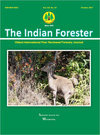A Review on Wildlife Rescue Activities in North Kerala, India
DOI:
https://doi.org/10.36808/if/2017/v143i10/119352Keywords:
Rescue, Rehabilitation, Wildlife Interactions, Awareness.Abstract
Human-wildlife interactions are increasing progressively with decrease in natural habitat. Of which, many of the interactions are detrimental to wildlife which had resulted in formation of Rapid Response Teams (RRT) in each district under the Forest Department. This data explains the present situation of rescue activities in North Kerala. The RRT of each district were visited and data on rescues such as number of rescues, species of animal rescued, date of rescue etc were collected, complied and interpreted. We also discuss on the limitation and include recommendations for better rescue and rehabilitation activities in the area.References
Ashraf N.V.K. and Menon V. (2005). Problems and Prospects of Rehabilitating Wildlife Displaced due to Man–Wildlife Conflict and the Wildlife Trade in India. In: Back to the Wild: Studies in Wildlife Rehabilitation. (V. Menon, N.V.K., Ashraf, P. Panda and K. Mainkar, Eds.), Conservation Reference Series 2. Wildlife Trust of India, New Delhi.
Berish J.E., Wendland L.D. and Gates C.A. (2000). Distribution and prevalence of upper respiratory tract disease in gopher tortoises in Florida. J. Herpetology, 34: 5–12.
Best R., Cooper J.E. and Mullineaux E. (2003). BSAVA Manual of Wildlife Casualties. British Small Animal Veterinary Association, Quedgeley, Gloucestershire
Cheyne S.M. (2006). Wildlife reintroduction: considerations of habitat quality at the release site. BMC Ecology, 6:5.
Griffith B., Scott J.M., Carpenter J.W. and Reed C. (1989). Translocation as a species conservation tool: status and strategy. Science, 245: 477–480.
Holcomb J. (1995). The ethics of wildlife rehabilitation. In: Proceedings of the SASOL Symposium on Wildlife Rehabilitation. (B.L. Penzhorn, Eds) Wildlife Group: South African Veterinary Association and Animal Rehabilitation Centre. 112-118 pp.
Kirkwood J.K. (2005). Kindness, Conservation or Keeping Alive? The Philosophy of Veterinary Treatment and Rehabilitation of Wildlife Casualties.In: Back to the Wild: Studies in Wildlife Rehabilitation. (V. Menon, N.V.K., Ashraf, P. Panda and K. Mainkar, Eds.), Conservation Reference Series 2. Wildlife Trust of India, New Delhi.
Kirkwood J.K. (2000). Ethical aspects of interventions for the conservation or welfare of wildlife. In: Veterinary Ethics - An Introduction. (G. Legood, Ed). Cassell, London. pp 121-138.
Kleiman D.G. (1989). Reintroduction of captive mammals for conservation. BioScience, 39: 152–161.
Kleiman D.G., Beck B.B., Dietz J.M. and Dietz L.A. (1991). Costs of a re-introduction and criteria for success: accounting and accountability in the Golden Lion Tamarin Conservation Program. Symposia of the Zoological Society of London, 62: 125-142.
Lorence S. (1991). The phone-old torment, new opportunity Bur. Wildl. Newsletter 2:6. N.Y. S. Dep. Environ. Conserv. Albany, N.Y.
Madsen T., Shine R., Olsson M., Wittzell H. (1999). Restoration of an inbred adder population. Nature, 402: 34–35.
McKegg J.S. (1984). Maryland's wildlife control cooperator program. Wildl. Soc. Bull., 12:414-416.
Rahbek C. (1993). Captive breeding – A useful tool in the preservation of biodiversity. Biodiversity and Conservation, 2: 426-437.
Reeve N. (2000). Post-release monitoring: the practicalities. In Proceedings of the Symposium of the British Wildlife Rehabilitation Council 2000 (R. Best and M. Small, Eds.), British Wildlife Rehabilitation Council.
Robinson I. (2005). Wildlife Rehabilitation as a Conservation and Welfare Prerogative. In: Back to the Wild: Studies in Wildlife Rehabilitation. (V. Menon, N.V.K., Ashraf, P. Panda and K. Mainkar, Eds.), Conservation Reference Series 2. Wildlife Trust of India, New Delhi.
Shine R. and Koenig J. (2001). Snakes in the garden: an analysis of reptiles ''rescued'' by community-based wildlife carers. Biological Conservation, 102: 271–283.
Short J. and Smith A. (1994). Mammal decline and recovery in Australia. J. Mammology, 75: 288–297.
Stanley–Price M. (1991). A review of mammal reintroductions, and the role of the Re-introduction Specialist Group of IUCN/SSC. In: Beyond captive breeding: Re-introducing endangered mammals to the wild. Symposium of the Zoological Society of London: 9–23 (J. H. W. Gipps, Ed.). Oxford University Press, New York, U.S.A.
Stocker L. (2000). Practical Wildlife Care. Blackwell Science, Oxford.
Tribe A. and Brown P.R. (2000). The role of wildlife rescue groups in the care and rehabilitation of Australian fauna. Human Dimen. Wildlife, 5: 69-85.
Wolf C.M., Griffith B., Reed C. and Temple S.A. (1996). Avian and mammal translocations: update and reanalysis of 1987 survey data. Conservation Biology, 10: 1142–1154.
Downloads
Downloads
Published
How to Cite
Issue
Section
License
Unless otherwise stated, copyright or similar rights in all materials presented on the site, including graphical images, are owned by Indian Forester.





